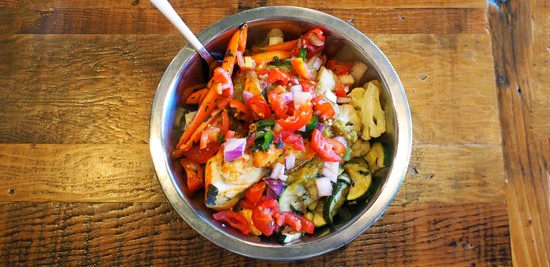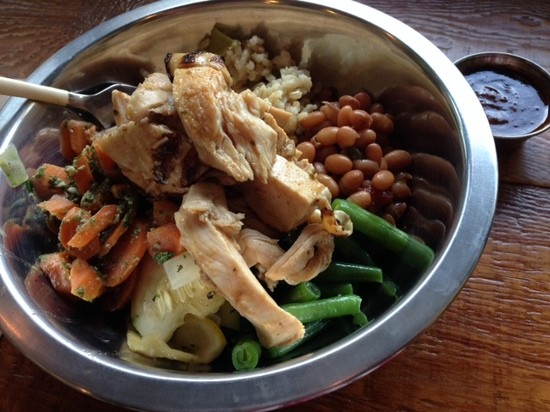
“Is she really going to put all that stuff into one bowl?” I thought to myself, eyeing the food on the steam tables that was not yet part of my meal. There were still three kinds of beans that looked rather watery, at least six different vegetables, three sauces and two meats. Most of them, I realized, were going to be piled, one after the other, into the same bowl as the brown rice I just asked for. How could all of that, um, stuff, possibly taste good mixed together? And how soggy is that rice going to be?
]
I was at Boldo Bol, the self-described “Earth-to-table” Santa Ana restaurant that sources its ingredients from not only local farmers, but also school gardens and CSAs. On its website, phrases such as “nutrient focused,” “ethically concerned” and “community supporting” are among its “holistic principles.” But I was convinced when I saw the metal mixing bowls that were used as serving plates that there's probably no restaurant in the whole of OC more eco-friendly, more socially responsible, more activist than this. Why the bowls? Well, aluminum mixing bowls are versatile. They don't break when dropped, they're easy to wash, and they're all about utility–function over form. Since the meal I was about to eat was obviously not aiming for aesthetics, the bowl was all that was needed to contain the food until I shoved it in my mouth.
When I finally scooped up the first forkful of my messy amalgam–rice, legume, veggie, sauce and meat all layered and slopped together as though an unintentional bibimbap–it made me realize how silly I was to expect this concoction to look a certain way. Presentation seemed a frivolous thing to demand when the sourcing had already been stripped down to cut out the middlemen and the cooking was done as simply as possible–boiling, roasting, nothing fried. Boldo Bol focuses on the essentials: flavor, texture, starch, vegetable, protein. And contrary to what I feared, those liquidy-looking lentils didn't turn anything in my bowl soggy; rather, it moistened everything, lubricating the green beans, the herbed carrots, the steamed broccoli and the rice.
The protein I chose–a small filet of black cod–was so soft it practically disintegrated, soon becoming another flavor component in the slurry. And there was already a lot of flavor. For saucing, I asked for a little bit of all three available. There was a light vegetable curry, a homemade harissa, and a broth-like seafood gumbo with bits of fish meat that could've been soup. All of this, again, was essentially poured over one another. Earlier, I was even asked if I wanted some of the homemade pico de gallo. Sure. Why not? In this mosh pit, the more the merrier. And, surprisingly, it all worked.
[

At some point during the meal, the owner told me, “We don't use a lot of salt,” then offered me a bottle of soy-sauce alternative and house-made chile vinegar. It wasn't necessary, but I used a few drops anyway. And when my iced tea was ready, I was invited to use the communal jar of honey on the counter should I opt to sweeten the drink. So I did. Never mind that the honey clumped into solid balls at the bottom of my biodegradable cup. Never mind that I was secretly wishing for a packet of good ol' C&H. It seemed too much to ask when the restaurant had a drying rack of herbs on the wall and a framed picture of its featured farmer of the day as though she were a deity.
Besides, I was feeling good after I devoured the bowl. My date did, too. Her chicken, in strips of snowy white, was steeped in a thinned-out harissa, and impossible as though it may seem, it actually did taste free-range and hormone-free. Most of all, we agreed that though we ate more than we usually eat in one sitting, the meal we consumed didn't bring on the usual pangs of calorie-and-fat-induced guilt. Was it the power of suggestion? Or was it just because nothing tasted less than wholesome?
I would return two more times, eating whatever was available, finding that the eggplant bartha was notably spicy and the only item that's kind of a chore to eat was the Verde Bowl, a salad of greens, daikon, cooked yam and pumpkin seeds in a dressing so tart it's painful. I also learned the brown rice was better than the usually overcooked white. And it's wisest to come earlier than dinnertime to see the vegetables at their optimal state. But to come at all is to reward one's karma. Somewhere in Berkeley, Michael Pollan is smiling.
Follow Stick a Fork in It on Twitter @ocweekly or on Facebook!

